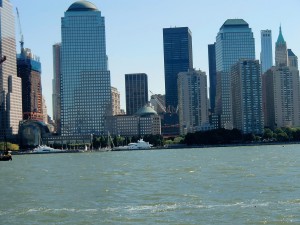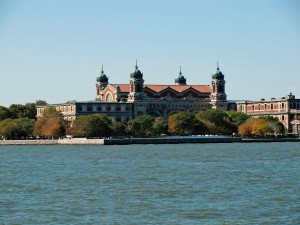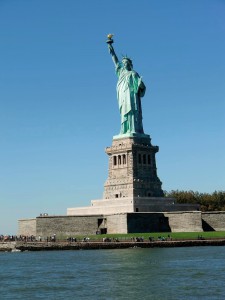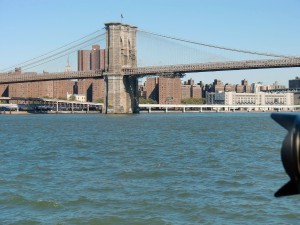EXPLORING NEW YORK
This is the first of a series of articles about traveling the byways of New York State
A DAY IN MANHATTAN (PART 1)
By Charles N. Stevens
Photos by Dolores Seidman
We’re excited today about our trip to the “Big Apple”, New York City. We leave from our hotel in Cranford, New Jersey, only a few miles from the Newark Airport where we landed yesterday.
The morning is perfect, bright and sunny, as we begin our trip over the Garden State Parkway, the highway landscaped to please the eye. New York comedians always joke about New Jersey, describing it as a smelly industrial wasteland. We do pass by industry and railroad yards and near unloading docks for containers where cranes point up to the sky like orange dinosaurs, but we don’t detect any odors. The oil refineries that sometimes give off a petroleum smell are south of us. Much of what we pass through is marsh land with inlets and ponds and tall feathery grasses leaning in a light breeze. Now and then we catch a glimpse of the shadowed iron-gray skyline of Manhattan.
By the time we reach Hoboken, New Jersey, the birthplace of Frank Sinatra, and are about to dive into the Lincoln Tunnel, the New York skyline stands before us in all its glory. Our bus plunges into the tunnel, the soft roar of cars and the red glare of tail lights reflecting off of its tile walls. The tunnel lights fly by as we approach its center, the dividing line between New Jersey and New York marked clearly on the wall with special tiles. We can’t help but think about all that water on top of us.
Emerging from the tunnel, we are in downtown Manhattan, the street ahead of us a dazzling, sun-filled canyon between the skyscrapers. We edge into the normal New York congestion of cars, trucks, taxies and buses, a part of being in Manhattan. Parked delivery trucks and the orange cones of construction projects slow us down even more. We’re enveloped in the sounds of car horns and accelerating vehicles as well as the yellow glare of a number of New York’s 12,000 taxies. We’re shocked at the prices for parking—$16.90 for twelve hours or $274.55 per month at one place and $14 per half hour at another.
With difficulty our skilled bus driver maneuvers through the crowded streets, finally getting us back to the waterfront. A cruise ship as big as a New York skyscraper rests at one dock while the gray structure gonflable massiveness of the retired aircraft carrier Intrepid is tied up at another. The aircraft carrier with its air museum is open to the public for a price. A bicycle path running parallel to the road is alive with joggers and bicycle riders.
We’re here at the waterfront to ride the Circle Line tourist boat that will take us down the west side of Manhattan, around the tip and up the east side. We join a line of tourists waiting to board, the buzz of sightseeing helicopters always above us. The screech of a floating dock as it rises and falls blends with the swoosh and slap of our boat as it bobs in the current.
We sit at a window seat in a large enclosed cabin watching the boat fill up with people, listening to piped-in loud music and looking down at the olive-colored seawater at the dock. We are at a point very close to where Captain Sullenberger ditched his U S Airways plane in the Hudson.
As we cruise south along the Hudson River we’re given ever changing views of Manhattan’s spectacular skyline, a sight unequaled in the world. We soon spot the 102-story Empire State Building standing out far above the others. New Jersey is across the river on our right, one of the bluffs near Weehawken being the site of Aaron Burr’s famous duel with Alexander Hamilton on July 11, 1804. Hamilton, severely injured, died the next day. The captain tells us that we are now passing over the Lincoln Tunnel where we entered the city only an hour before. It’s hard to imagine that a stream of cars is far down below us. As it is Saturday, sail boats tack in the wind and jet skis cut through the water.
Hoboken is now on our right, a city that was in decline, but is now becoming gentrified. Just south of it at Newport, New Jersey new high rise apartment buildings reach for the sky, the demand for living space in the area being acute.
We cruise by the sad sight of “ground zero” on our left, an area we’ll examine closer later. The new Freedom Tower begins to rise out of the devastation and will eventually be the tallest structure in the city. Ahead of us is the hazy gray span of the Verrazano Bridge with the Atlantic Ocean beyond.
One of the highlights of our trip now appears on our right, the reddish-tan brick towers of Ellis Island where thousands of immigrants entered our country, and nearby, the pale green majesty of the Statue of Liberty, her gleaming golden torch raised high. Other tourist boats packed with people circle around these two special monuments. Ahead of us the bright orange Staten Island Ferry plows across the river. This ferry is the only thing in New York that is free.
We begin to skirt around the tip of Manhattan, about to leave the Hudson River and enter the East River. Part of the tip, once a fortress is still called the Battery. We float past the ferry terminals and the busy heliport where all the tourist choppers are launched. The high rise buildings of the financial district near Wall Street loom above them. We can almost smell the money.
Now in the East River, we have our first view of the famous Brooklyn Bridge built in 1883 and still a vital link between Manhattan and Brooklyn. Cars and pedestrians stream across it. The tall buildings of downtown Brooklyn are now on our right. On our left is the Lower East Side, now a high priced living area, but once the location of tenements housing new immigrants. On our right is the Brooklyn Navy Yard, formerly bustling but now used sparingly for repairing Navy ships.
It is interesting to realize that Manhattan is only thirteen miles long and just over two miles wide, making it easy to understand from a tour boat. Green parks occupy part of the shore along the east side. Soccer players run around a green field while onlookers cheer them on. Others jog or stroll along shadowed paths. We spot the backside of the 1929 Empire State Building and the Chrysler Building as well as a geometric forest of towering apartment buildings. On our right are the remains of the Domino Sugar Plant, soon to be converted into lofts and apartments to satisfy New York’s insatiable appetite for living space.
As our boat comes about for the return trip we have a short view of Queens and the west end of Long Island.
(To be continued)

From the Circle Line boat we have a great view of the New York skyline.

We pass Ellis Island where thousands of immigrants reached our shores.

The Statue of Liberty still greets us

The Brooklyn Bridge, over 100 years old, still carries its share of traffic



